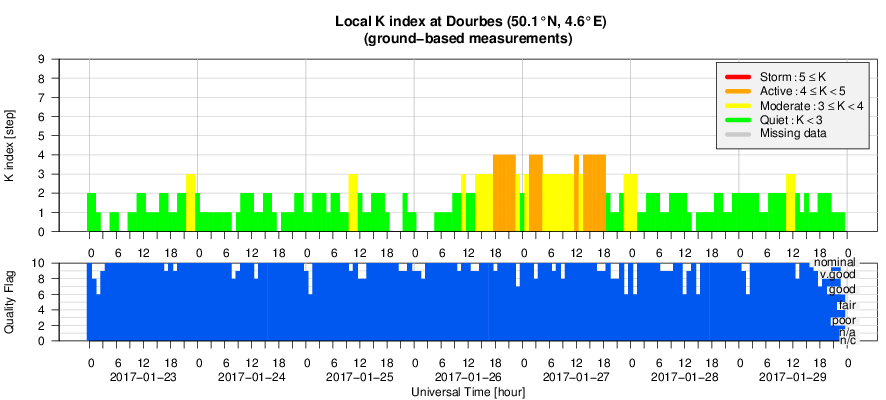- Table of Content
- 1.STCE Workshop ...
- 2.The STCE meets
- 3.PROBA2 Observa...
- 4.Review of sola...
- 5.The Internatio...
- 6.Geomagnetic Ob...
- 7.Review of iono...
- 8.Future Events
2. The STCE meets
3. PROBA2 Observations (23 Jan 2017 - 29 Jan 2017)
4. Review of solar and geomagnetic activity
5. The International Sunspot Number
6. Geomagnetic Observations at Dourbes (23 Jan 2017 - 29 Jan 2017)
7. Review of ionospheric activity (23 Jan 2017 - 29 Jan 2017)
8. Future Events
STCE Workshop "Geomagnetic storms and solar eruptions: from Sun to Earth"
On 31 January, the STCE Workshop "Geomagnetic storms and solar eruptions: from Sun to Earth" took place in the cozy meeting room of the RMI. Thirty-nine (39!) participants got submerged on the modeling of drivers of geomagnetic storms and solar storms as well as their impact on the geospace environment. The workshop was chaired by Dr Véronique Delouille (ROB), and consisted of 7 talks each followed by a few minutes of Q and A. An overview and links to some of the talks can be found at https://events.oma.be/indico/event/21/
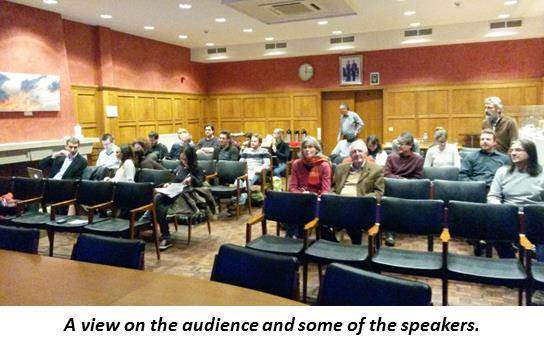
Dr Raluca Ilie from the University of Illinois introduced the SWMF (Space Weather Modeling Framework) which is designed to simulate the global space environment. She impressed the audience with the encouraging results obtained so far, as well as with the 600.000 lines of source code that were written for the model. Next came Dr Marilena Mierla (ROB) who focused on two gaps which we still do not understand very well: what happens between Sun and Earth (propagation of the coronal mass ejection (CME) and interaction with the background solar wind), and the coupling mechanisms between the CME as it arrives at Earth and the subsequent geomagnetic disturbance it may cause.
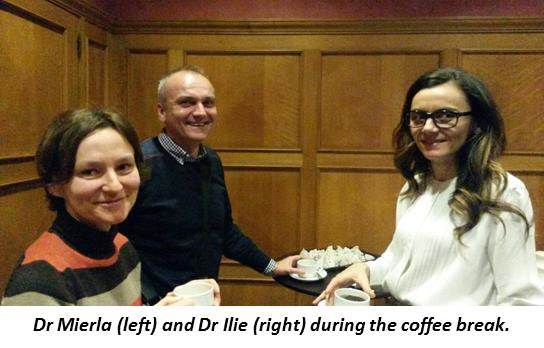
After the coffee break, Professor Farzad Kamalabadi (University of Illinois) gave an overview of the ICON mission (Ionospheric CONnection explorer) which is due for launch later this year. ICON's main task will be to improve our understanding how the planetary weather dynamo works and how it controls our space environment. Also the modeling of Geomagnetically Induced Currents (GIC) from ground-based magnetometer measurements was discussed. The morning session was concluded by Professor Joseph Lemaire (BISA and UCL) who illustrated the results from the EPT (Energetic Particle Telescope) on board the PROBA-V satellite with the St-Patrick's Day storm of 17 March 2015, the strongest geomagnetic storm so far this solar cycle.
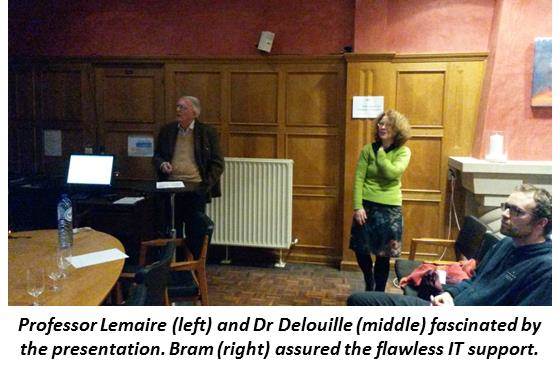
The RMI kindly served the lunch break in the canteen. After soup, a myriad of sandwiches, and a revealing analysis of fingertalk, the participants were ready for more (talks). They were entertained by Dr Herbert Gunnell (BISA) who discussed the upward and downward current regions of the aurora. Dr Jasmina Magdalenic (ROB) presented the EUHFORIA model. This "EUropean Heliospheric FORecasting Information Asset", developed by the KUL, predicts the space conditions near Earth by using three models: a coronal model, a magnetohydrodynamic heliosphere model, and an eruption model that allows the injection of CMEs. The model gives already very good results, as demonstrated with the recent arrival of a high speed stream from a coronal hole. Some observational tools such as LOFAR (LOw Frequency ARray) were also highlighted.
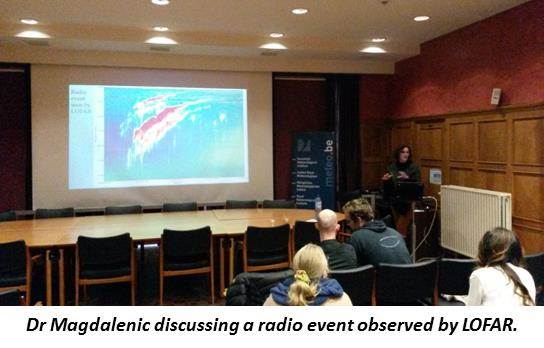
Dr Andrei Zhukov (ROB) concluded the workshop with a talk on the prediction of geomagnetic storms from the orientation and intensity of Bz, i.e. the north-south component of the interplanetary magnetic field. Indeed, a negative, strong and long-lasting Bz is required for a strong geomagnetic storm. Though we may have a reasonably educated guess of this parameter close to the solar surface (solar eruption, CME shape), various factors introduce uncertainties in the CME's Bz when it is en route to Earth. Many more case-studies will be required.
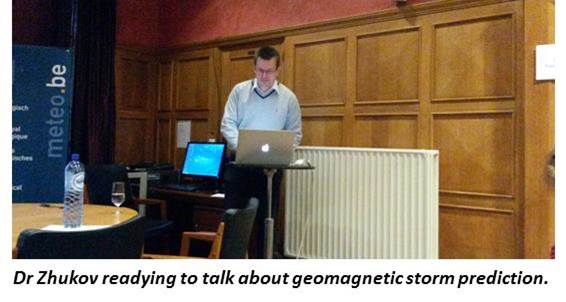
The STCE meets
You are the first to know: Thursday June 8, 2017, STCE annual meeting in the theme 'Dark and Dusty'
More info will follow when available.
Mark your calendar!
the STCE

PROBA2 Observations (23 Jan 2017 - 29 Jan 2017)
Solar Activity
Solar flare activity fluctuated between very low and low during the week.
In order to view the activity of this week in more detail, we suggest to go to the following website from which all the daily (normal and difference) movies can be accessed: http://proba2.oma.be/ssa
This page also lists the recorded flaring events.
A weekly overview movie can be found here (SWAP week 357).
http://proba2.oma.be/swap/data/mpg/movies/weekly_movies/weekly_movie_2017_01_23.mp4
Details about some of this week’s events, can be found further below.
If any of the linked movies are unavailable they can be found in the P2SC movie repository here
http://proba2.oma.be/swap/data/mpg/movies/
Tuesday Jan 24
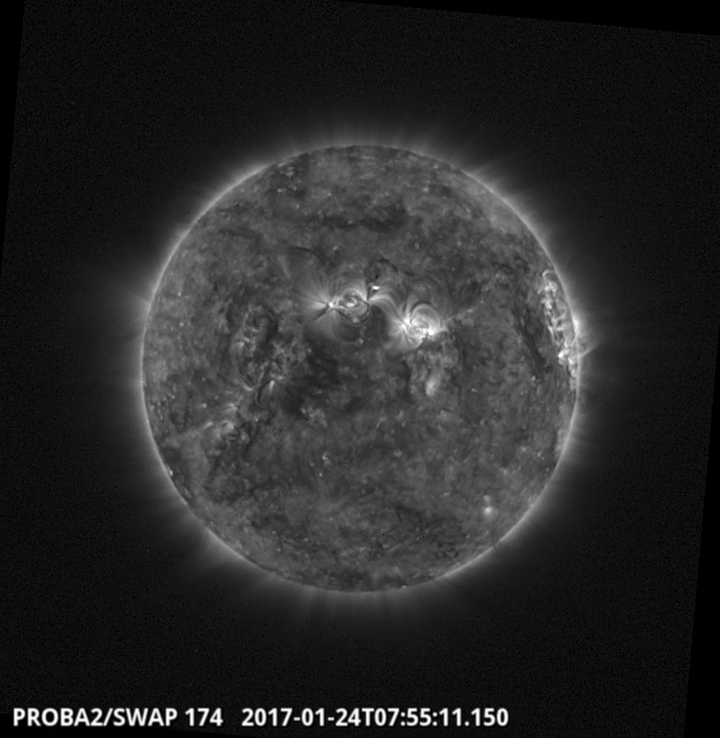
A filament eruption was observed in the center-North region of the Sun between the two active regions AR 2627 and AR 2628 - which can be seen in the above SWAP image.
Find a movie of the events here (SWAP movie)
http://proba2.oma.be/swap/data/mpg/movies/20170124_swap_movie.mp4
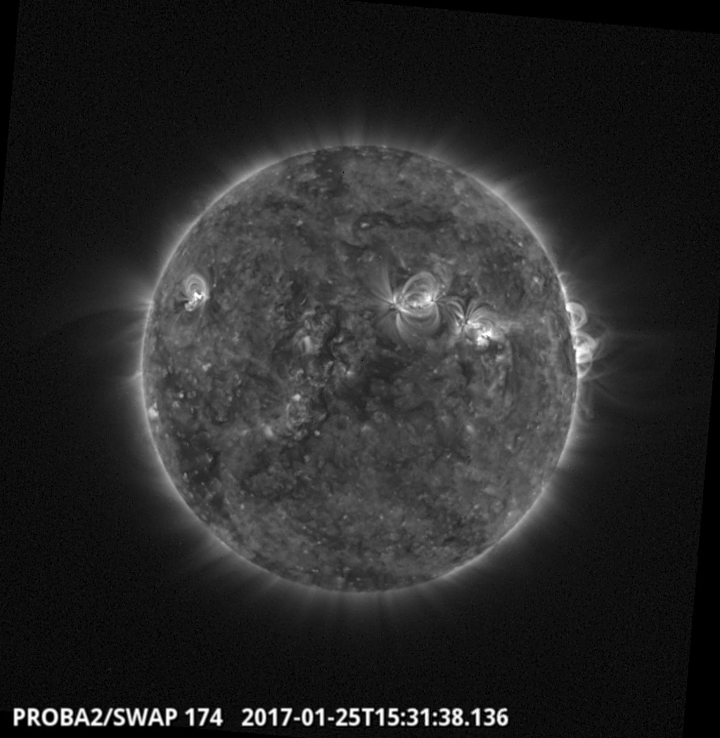
AR 2629 produced several B class Flares from Jan 24 until Jan 27. One of them, on January 25 at 15:31 UT in North East Quadrant - Which can be seen in the above SWAP image
Find a movie of the events here (SWAP movie)
http://proba2.oma.be/swap/data/mpg/movies/20170125_swap_movie.mp4
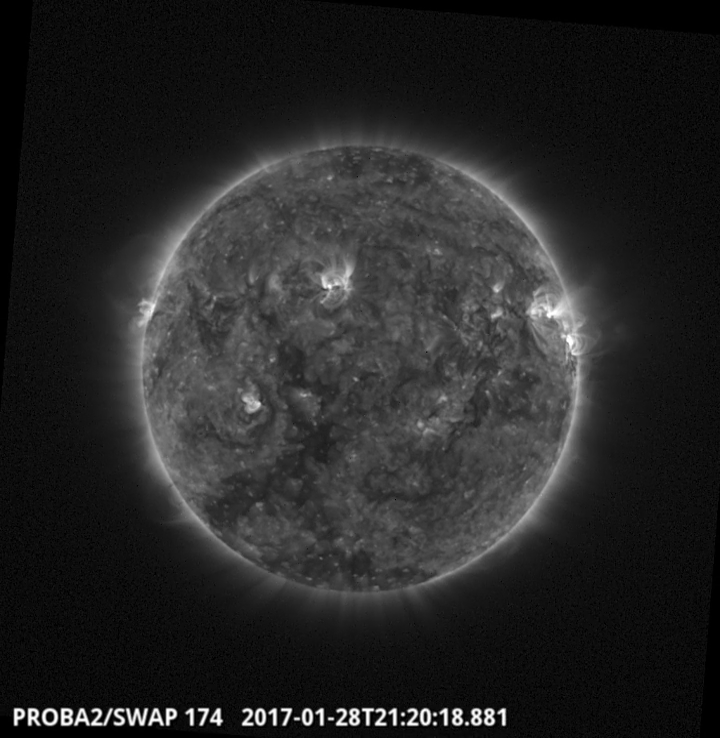
AR 2627, close to North West Limb, produced a C-class flare on January 28 at 21:20 UT - which can be seen in the above SWAP image
Find a movie of the events here (SWAP movie)
http://proba2.oma.be/swap/data/mpg/movies/20170128_swap_movie.mp4
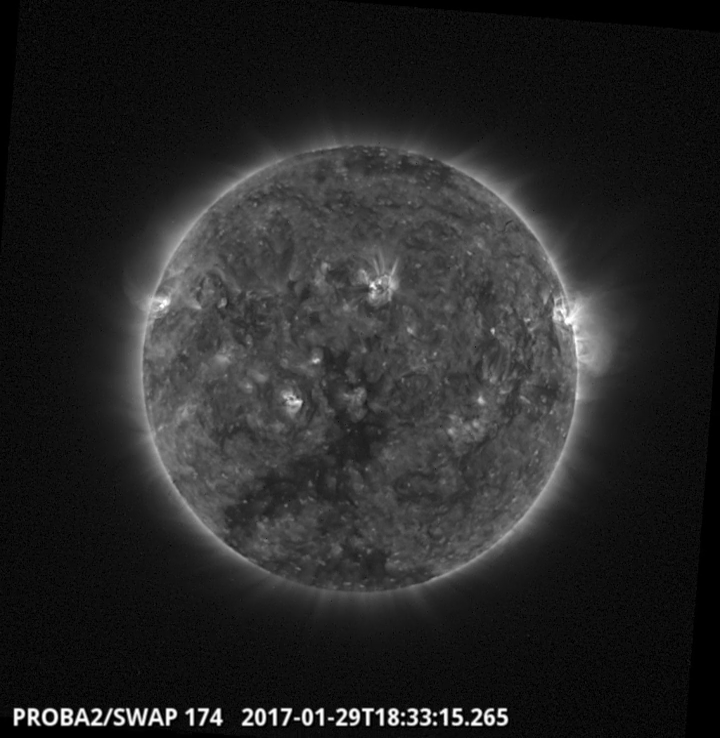
A Southern trans-equatorial coronal hole, which produced enhanced geomagnetic conditions at the Earth during its previous transit of the solar disk can be seen in the above SWAP image
Find a movie of the event here (SWAP movie)
http://proba2.oma.be/swap/data/mpg/movies/20170129_swap_movie.mp4
Review of solar and geomagnetic activity
Solar Activity
Solar activity was very low to low, with a single C-class flare produced by a spotless active region NOAA 2627 near the west limb on 28 January (C2 flare peaking at 21:09UT). A new region, NOAA 2629, developed quickly on 24 January and was responsible for most of the B-class flaring on 24-26 January. The other regions were mostly quiet and decaying. No earth-directed coronal mass ejections (CMEs) were observed in available coronagraphic imagery. The greater than 10MeV proton flux was at nominal levels. A small positive equatorial coronal hole (CH) started its transit of the central meridian on 23 January, and a negative trans-equatorial CH was transiting the central meridian (CM) by the end of the period.
Geomagnetic Activity
Solar wind conditions near Earth were determined by the high speed stream
(HSS) from the small positive coronal hole (CH). The co-rotating
interaction region (CIR) that preceded it, drove a small shock on 26 January at 07:12UT. The proper HSS arrived a few hours later around 13:45UT of the same day, with solar wind speed gradually increasing from an initial 375 km/s up to values near 670 km/s around 06UT on 27 January. Bz oscillated wildly between -12 nT and +13 nT, preventing the development of a strong geomagnetic disturbance. As a result, only active geomagnetic conditions were observed on 26 and 27 January, while the rest of the week was at quiet levels with an occasional unsettled episode.
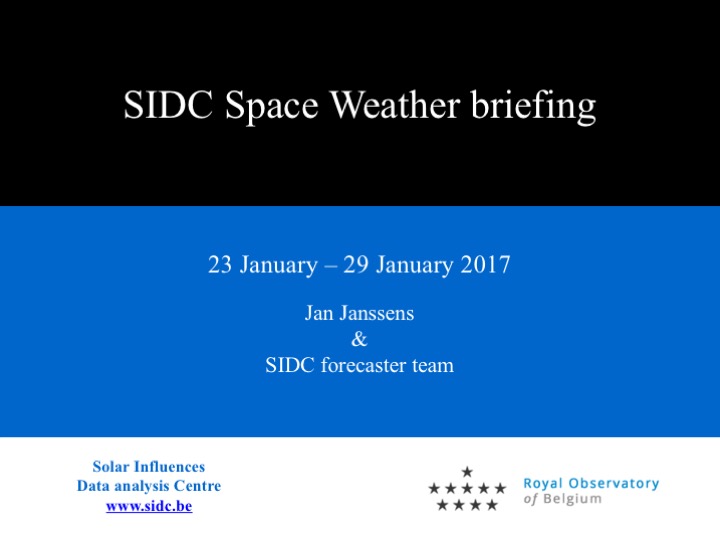
The space weather briefing as a ppsm : http://www.stce.be/movies/SIDCbriefing-2017-01-30_pv.ppsm
The International Sunspot Number
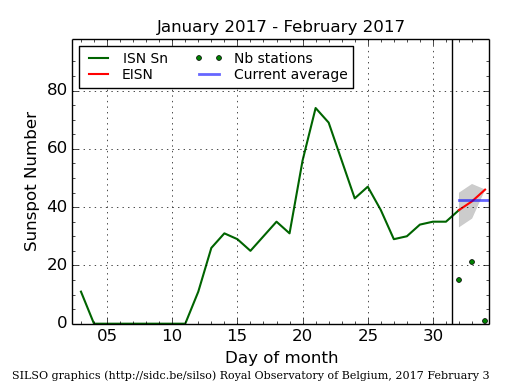
The daily Estimated International Sunspot Number (EISN, red curve with shaded error) derived by a simplified method from real-time data from the worldwide SILSO network. It extends the official Sunspot Number from the full processing of the preceding month (green line). The plot shows the last 30 days (about one solar rotation). The horizontal blue line shows the current monthly average, while the green dots give the number of stations included in the calculation of the EISN for each day.
Review of ionospheric activity (23 Jan 2017 - 29 Jan 2017)
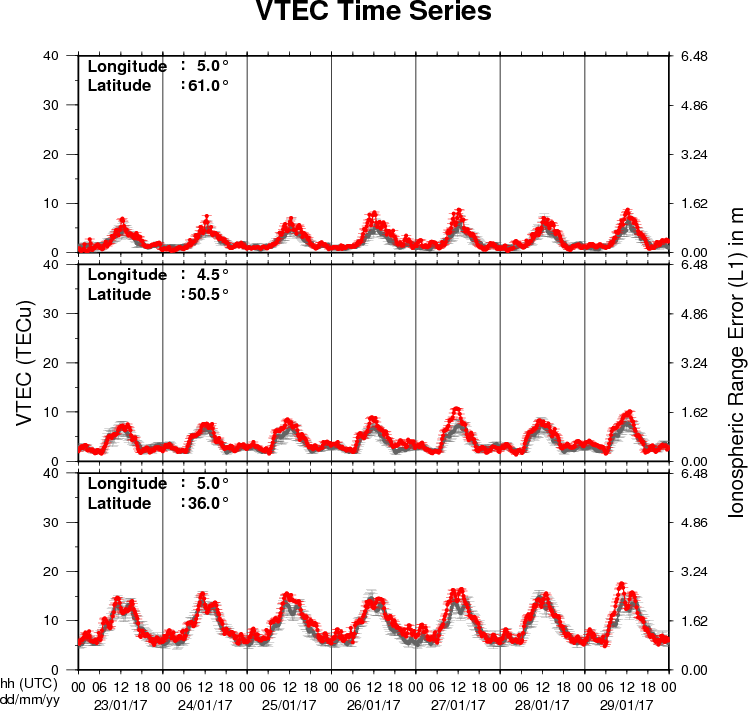
The figure shows the time evolution of the Vertical Total Electron Content (VTEC) (in red) during the last week at three locations:
a) in the northern part of Europe(N61°, 5°E)
b) above Brussels(N50.5°, 4.5°E)
c) in the southern part of Europe(N36°, 5°E)
This figure also shows (in grey) the normal ionospheric behaviour expected based on the median VTEC from the 15 previous days.
The VTEC is expressed in TECu (with TECu=10^16 electrons per square meter) and is directly related to the signal propagation delay due to the ionosphere (in figure: delay on GPS L1 frequency).
The Sun's radiation ionizes the Earth's upper atmosphere, the ionosphere, located from about 60km to 1000km above the Earth's surface.The ionization process in the ionosphere produces ions and free electrons. These electrons perturb the propagation of the GNSS (Global Navigation Satellite System) signals by inducing a so-called ionospheric delay.
See http://stce.be/newsletter/GNSS_final.pdf for some more explanations ; for detailed information, see http://gnss.be/ionosphere_tutorial.php
Future Events
For more details, see http://www.spaceweather.eu/en/event/future
International CCMC-LWS Workshop in Cape Canaveral, Florida (USA)
Start : 2017-04-03 - End : 2017-04-07
The goal of this working meeting is to address the need to
quantify and to track progress over time in the field of space
weather and to establish internationally recognized metrics that
are meaningful to end-users and developers. Defining a set of
appropriate metrics is important to track advancements in space
weather understanding and predictive capabilities.
This meeting is a part of the unfolding activities of the
International Forum for Space Weather Capabilities Assessment that
brings together space environment experts, model and application
developers, data providers, forecasters and end-users. The goals of
this community-wide forum include addressing challenges in
model-data comparisons and evaluating the current state of space
environment predictive capabilities. Workshop attendance is
encouraged but is not a requirement for joining forum teams.
Website:
http://ccmc.gsfc.nasa.gov/CCMC-LWS_Meeting/
Solar Orbiter Workshop 7: Exploring the solar environs in Granada, Spain
Start : 2017-04-03 - End : 2017-04-06
This event will be hosted by the Instituto de Astrofisica de
Andalucia - CSIC. Please mind that on April 7th the 20th SWT
meeting will take place at the same venue.
Website: Unkown
URSI General Assembly in Montreal, Canada
Start : 2017-08-19 - End : 2017-08-26
For the thirty-second time since the inception of URSI, Radio
Scientists from across the world will get together for the URSI
General Assembly and Scientific Symposium. This triennial gathering
will take place from 19th to 26th of August 2017, in Montreal,
Canada. This conference is a unique opportunity to learn about
recent advances in all fields of Radio Science, as covered by all
ten URSI Commissions.
Among the different sessions, please note:
* 'Radio Science for Space Weather'
Conveners: M. Messerotti, V. Pierrard
* 'Remote Sensing and Modeling of the Earth's Plasmasphere
and Plasmapause'
Conveners: A. M. Jorgensen, V. Pierrard, B. Heilig
The abstract deadline is 30 January 2017
Website: http://www.ursi2017.org
Workshops on Radiation Monitoring for the International Space Station in Torino, Italy
Start : 2017-09-05 - End : 2017-09-07
The Workshop on Radiation Monitoring for the International Space
Station is an annual meeting to discuss the scientific definition
of an adequate radiation monitoring package and its use by the
scientific community on the ISS. Types of instruments and research
topics need to be defined in order to optimise the radiation safety
of the ISS crew.
Website: http://wrmiss.org/
European Space Weather Week 14
Start : 2017-11-27 - End : 2017-12-01
The ESWW is the main annual event in the European Space Weather
calendar. It is the European forum for Space Weather as proven by
the high attendance to the past editions. The agenda will be
composed of plenary/parallel sessions, working meetings and
dedicated events for service end-users. The ESWW will again adopt
the central aim of bringing together the diverse groups in Europe
working on different aspects of Space Weather.
Website:
http://www.stce.be/esww14/
